Cybercrime Law: Analysis of Community Bank and Barnes & Noble Cases
VerifiedAdded on 2022/11/29
|8
|1683
|301
Case Study
AI Summary
This assignment presents a comprehensive analysis of two critical cybercrime law case studies: Community Bank of Trenton v. Schnuck Markets, Inc., and Dieffenbach v. Barnes & Noble, Inc. The paper meticulously examines the facts of each case, identifying the involved parties, the motivations behind their actions, and the sequence of events leading to the legal disputes. It dissects the core legal and public policy issues at the heart of these cases, framing them as questions to facilitate a deeper understanding of the complexities involved. Furthermore, the assignment explores the arguments presented by both sides, including the legal and practical implications. It provides a detailed examination of the arguments, including the pros and cons. The paper concludes by summarizing the outcomes of each case, highlighting the court's decisions, and discussing the broader implications for cyber security, data protection, and consumer rights within the context of cybercrime law. The assignment is designed to provide an in-depth understanding of the legal landscape surrounding data breaches and cybercrime.
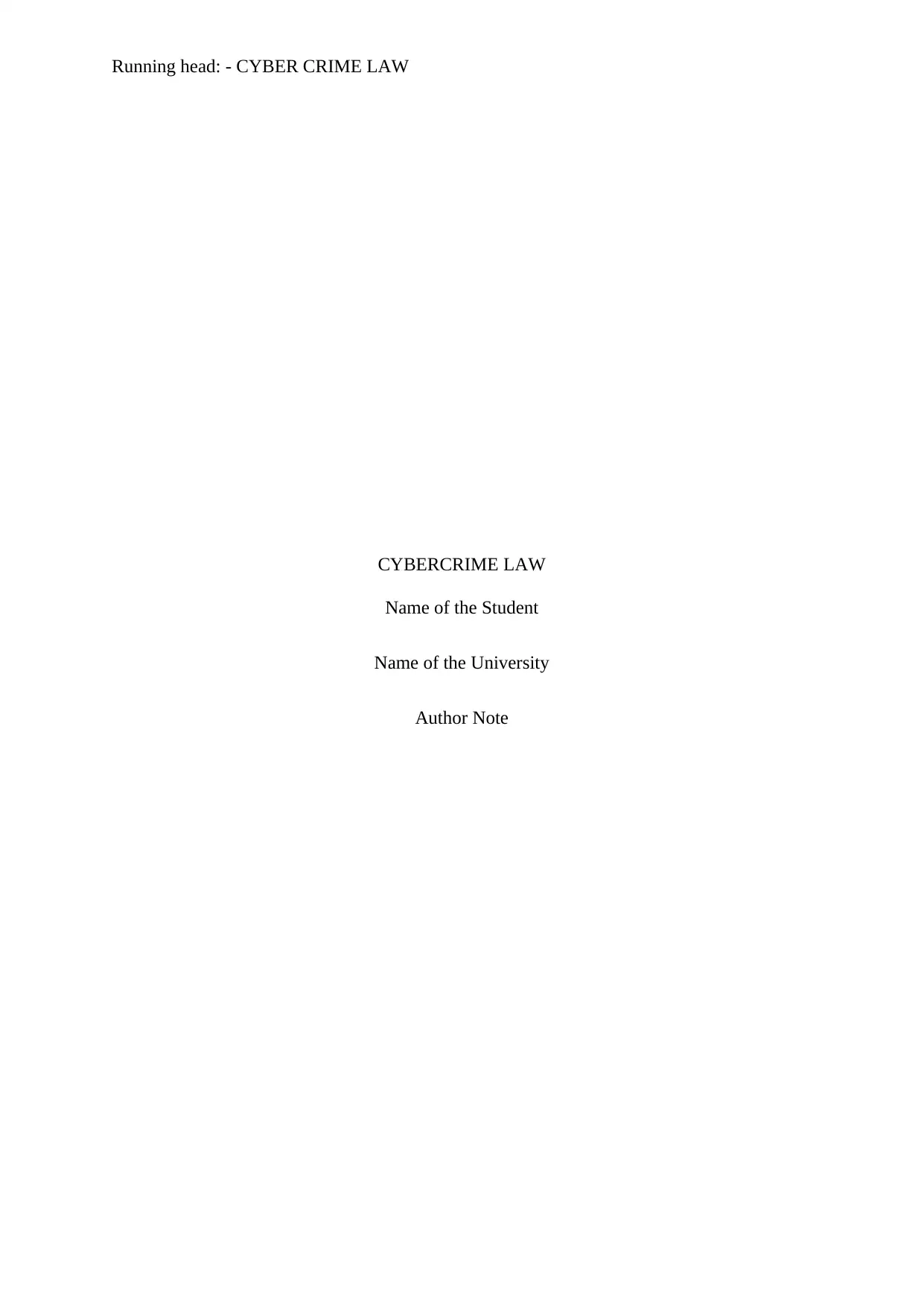
Running head: - CYBER CRIME LAW
CYBERCRIME LAW
Name of the Student
Name of the University
Author Note
CYBERCRIME LAW
Name of the Student
Name of the University
Author Note
Paraphrase This Document
Need a fresh take? Get an instant paraphrase of this document with our AI Paraphraser
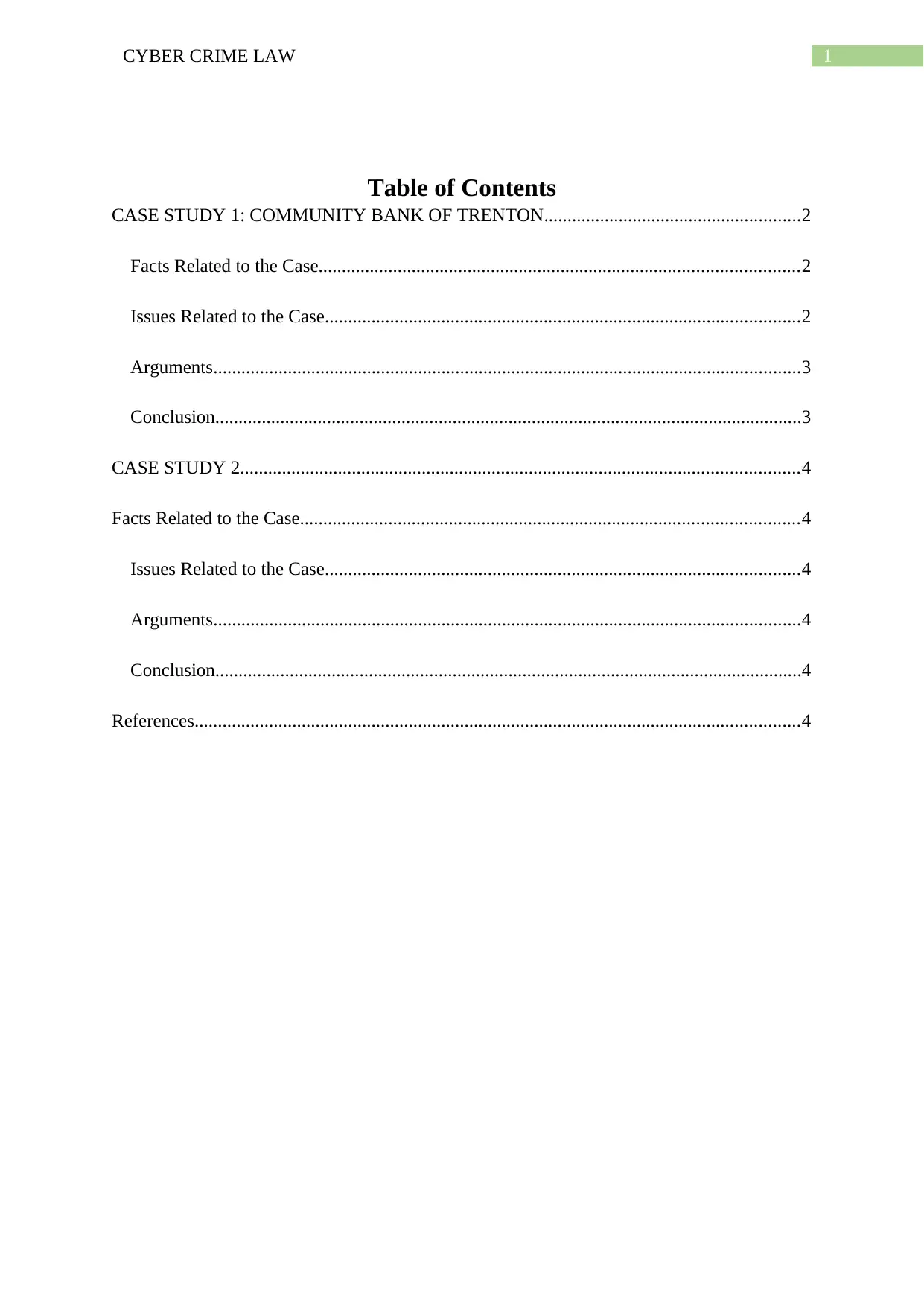
1CYBER CRIME LAW
Table of Contents
CASE STUDY 1: COMMUNITY BANK OF TRENTON.......................................................2
Facts Related to the Case.......................................................................................................2
Issues Related to the Case......................................................................................................2
Arguments..............................................................................................................................3
Conclusion..............................................................................................................................3
CASE STUDY 2........................................................................................................................4
Facts Related to the Case...........................................................................................................4
Issues Related to the Case......................................................................................................4
Arguments..............................................................................................................................4
Conclusion..............................................................................................................................4
References..................................................................................................................................4
Table of Contents
CASE STUDY 1: COMMUNITY BANK OF TRENTON.......................................................2
Facts Related to the Case.......................................................................................................2
Issues Related to the Case......................................................................................................2
Arguments..............................................................................................................................3
Conclusion..............................................................................................................................3
CASE STUDY 2........................................................................................................................4
Facts Related to the Case...........................................................................................................4
Issues Related to the Case......................................................................................................4
Arguments..............................................................................................................................4
Conclusion..............................................................................................................................4
References..................................................................................................................................4
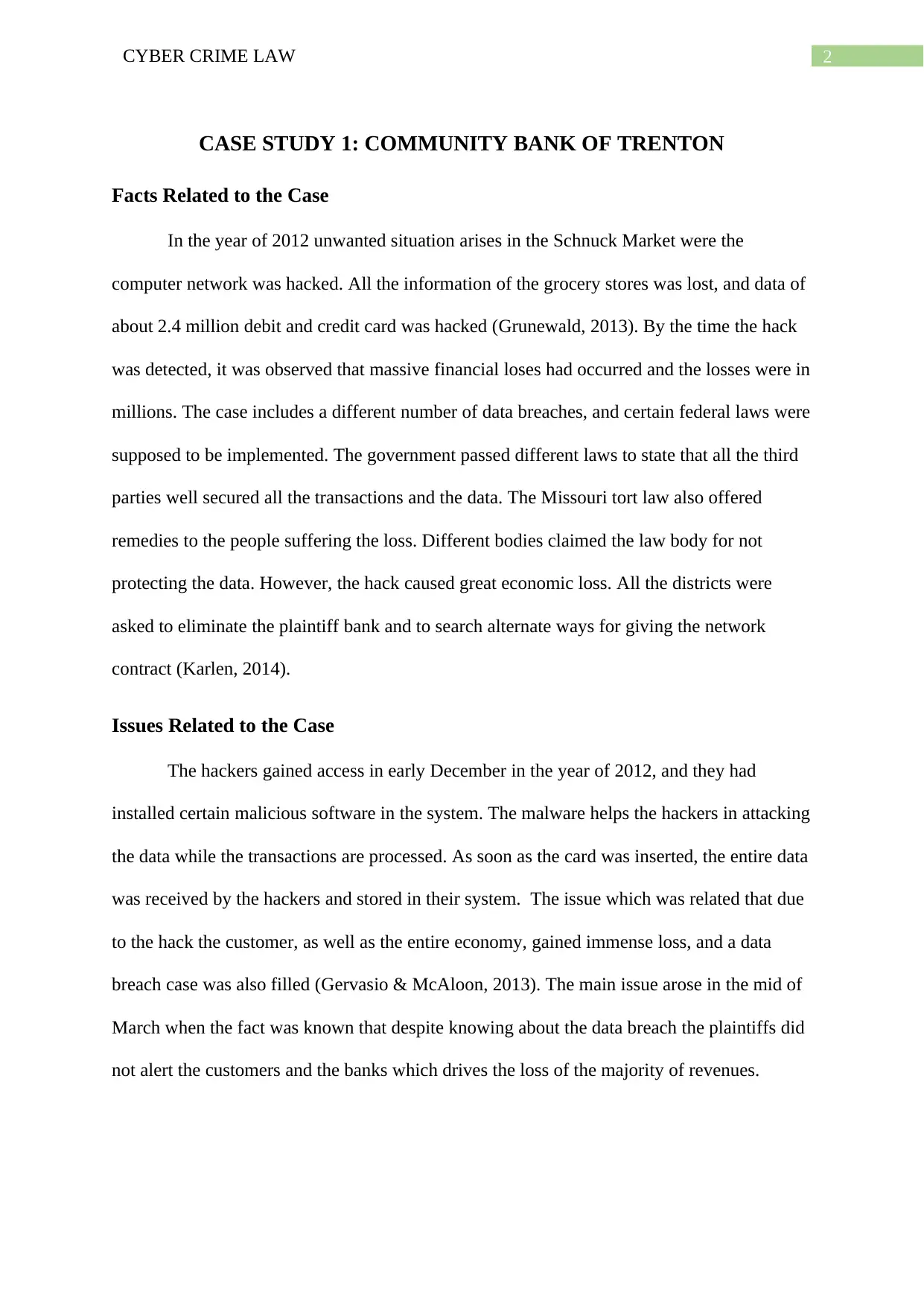
2CYBER CRIME LAW
CASE STUDY 1: COMMUNITY BANK OF TRENTON
Facts Related to the Case
In the year of 2012 unwanted situation arises in the Schnuck Market were the
computer network was hacked. All the information of the grocery stores was lost, and data of
about 2.4 million debit and credit card was hacked (Grunewald, 2013). By the time the hack
was detected, it was observed that massive financial loses had occurred and the losses were in
millions. The case includes a different number of data breaches, and certain federal laws were
supposed to be implemented. The government passed different laws to state that all the third
parties well secured all the transactions and the data. The Missouri tort law also offered
remedies to the people suffering the loss. Different bodies claimed the law body for not
protecting the data. However, the hack caused great economic loss. All the districts were
asked to eliminate the plaintiff bank and to search alternate ways for giving the network
contract (Karlen, 2014).
Issues Related to the Case
The hackers gained access in early December in the year of 2012, and they had
installed certain malicious software in the system. The malware helps the hackers in attacking
the data while the transactions are processed. As soon as the card was inserted, the entire data
was received by the hackers and stored in their system. The issue which was related that due
to the hack the customer, as well as the entire economy, gained immense loss, and a data
breach case was also filled (Gervasio & McAloon, 2013). The main issue arose in the mid of
March when the fact was known that despite knowing about the data breach the plaintiffs did
not alert the customers and the banks which drives the loss of the majority of revenues.
CASE STUDY 1: COMMUNITY BANK OF TRENTON
Facts Related to the Case
In the year of 2012 unwanted situation arises in the Schnuck Market were the
computer network was hacked. All the information of the grocery stores was lost, and data of
about 2.4 million debit and credit card was hacked (Grunewald, 2013). By the time the hack
was detected, it was observed that massive financial loses had occurred and the losses were in
millions. The case includes a different number of data breaches, and certain federal laws were
supposed to be implemented. The government passed different laws to state that all the third
parties well secured all the transactions and the data. The Missouri tort law also offered
remedies to the people suffering the loss. Different bodies claimed the law body for not
protecting the data. However, the hack caused great economic loss. All the districts were
asked to eliminate the plaintiff bank and to search alternate ways for giving the network
contract (Karlen, 2014).
Issues Related to the Case
The hackers gained access in early December in the year of 2012, and they had
installed certain malicious software in the system. The malware helps the hackers in attacking
the data while the transactions are processed. As soon as the card was inserted, the entire data
was received by the hackers and stored in their system. The issue which was related that due
to the hack the customer, as well as the entire economy, gained immense loss, and a data
breach case was also filled (Gervasio & McAloon, 2013). The main issue arose in the mid of
March when the fact was known that despite knowing about the data breach the plaintiffs did
not alert the customers and the banks which drives the loss of the majority of revenues.
⊘ This is a preview!⊘
Do you want full access?
Subscribe today to unlock all pages.

Trusted by 1+ million students worldwide
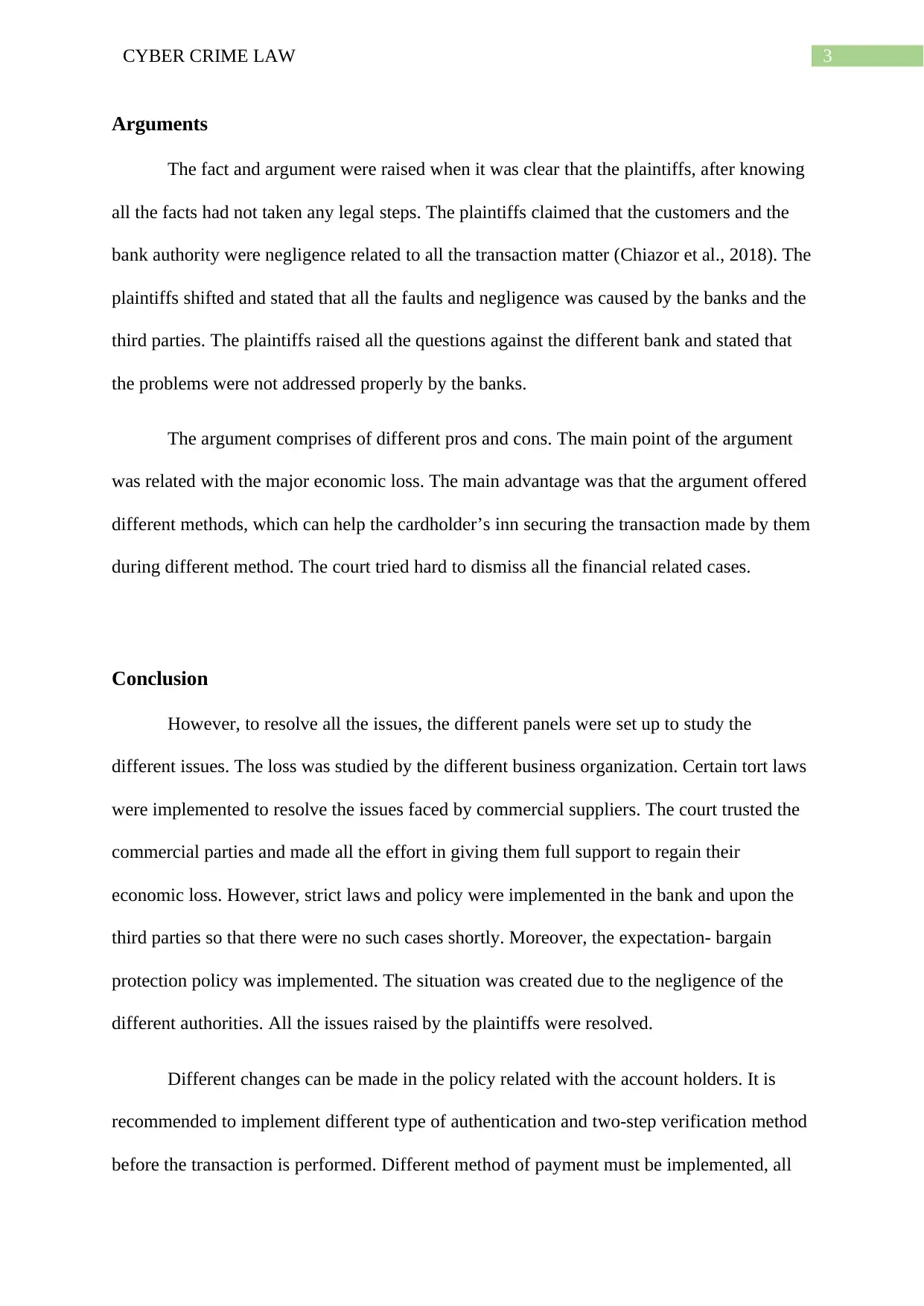
3CYBER CRIME LAW
Arguments
The fact and argument were raised when it was clear that the plaintiffs, after knowing
all the facts had not taken any legal steps. The plaintiffs claimed that the customers and the
bank authority were negligence related to all the transaction matter (Chiazor et al., 2018). The
plaintiffs shifted and stated that all the faults and negligence was caused by the banks and the
third parties. The plaintiffs raised all the questions against the different bank and stated that
the problems were not addressed properly by the banks.
The argument comprises of different pros and cons. The main point of the argument
was related with the major economic loss. The main advantage was that the argument offered
different methods, which can help the cardholder’s inn securing the transaction made by them
during different method. The court tried hard to dismiss all the financial related cases.
Conclusion
However, to resolve all the issues, the different panels were set up to study the
different issues. The loss was studied by the different business organization. Certain tort laws
were implemented to resolve the issues faced by commercial suppliers. The court trusted the
commercial parties and made all the effort in giving them full support to regain their
economic loss. However, strict laws and policy were implemented in the bank and upon the
third parties so that there were no such cases shortly. Moreover, the expectation- bargain
protection policy was implemented. The situation was created due to the negligence of the
different authorities. All the issues raised by the plaintiffs were resolved.
Different changes can be made in the policy related with the account holders. It is
recommended to implement different type of authentication and two-step verification method
before the transaction is performed. Different method of payment must be implemented, all
Arguments
The fact and argument were raised when it was clear that the plaintiffs, after knowing
all the facts had not taken any legal steps. The plaintiffs claimed that the customers and the
bank authority were negligence related to all the transaction matter (Chiazor et al., 2018). The
plaintiffs shifted and stated that all the faults and negligence was caused by the banks and the
third parties. The plaintiffs raised all the questions against the different bank and stated that
the problems were not addressed properly by the banks.
The argument comprises of different pros and cons. The main point of the argument
was related with the major economic loss. The main advantage was that the argument offered
different methods, which can help the cardholder’s inn securing the transaction made by them
during different method. The court tried hard to dismiss all the financial related cases.
Conclusion
However, to resolve all the issues, the different panels were set up to study the
different issues. The loss was studied by the different business organization. Certain tort laws
were implemented to resolve the issues faced by commercial suppliers. The court trusted the
commercial parties and made all the effort in giving them full support to regain their
economic loss. However, strict laws and policy were implemented in the bank and upon the
third parties so that there were no such cases shortly. Moreover, the expectation- bargain
protection policy was implemented. The situation was created due to the negligence of the
different authorities. All the issues raised by the plaintiffs were resolved.
Different changes can be made in the policy related with the account holders. It is
recommended to implement different type of authentication and two-step verification method
before the transaction is performed. Different method of payment must be implemented, all
Paraphrase This Document
Need a fresh take? Get an instant paraphrase of this document with our AI Paraphraser
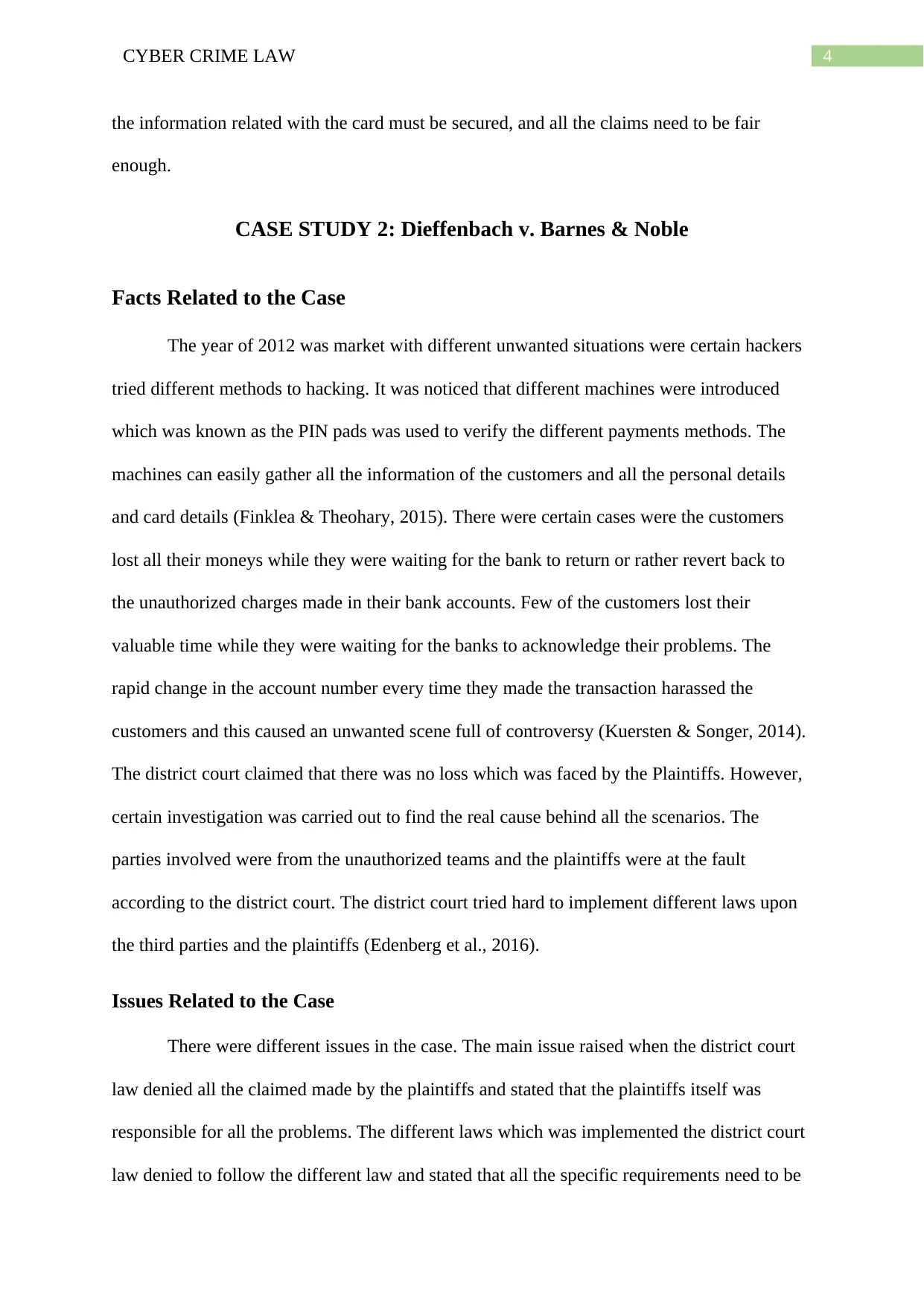
4CYBER CRIME LAW
the information related with the card must be secured, and all the claims need to be fair
enough.
CASE STUDY 2: Dieffenbach v. Barnes & Noble
Facts Related to the Case
The year of 2012 was market with different unwanted situations were certain hackers
tried different methods to hacking. It was noticed that different machines were introduced
which was known as the PIN pads was used to verify the different payments methods. The
machines can easily gather all the information of the customers and all the personal details
and card details (Finklea & Theohary, 2015). There were certain cases were the customers
lost all their moneys while they were waiting for the bank to return or rather revert back to
the unauthorized charges made in their bank accounts. Few of the customers lost their
valuable time while they were waiting for the banks to acknowledge their problems. The
rapid change in the account number every time they made the transaction harassed the
customers and this caused an unwanted scene full of controversy (Kuersten & Songer, 2014).
The district court claimed that there was no loss which was faced by the Plaintiffs. However,
certain investigation was carried out to find the real cause behind all the scenarios. The
parties involved were from the unauthorized teams and the plaintiffs were at the fault
according to the district court. The district court tried hard to implement different laws upon
the third parties and the plaintiffs (Edenberg et al., 2016).
Issues Related to the Case
There were different issues in the case. The main issue raised when the district court
law denied all the claimed made by the plaintiffs and stated that the plaintiffs itself was
responsible for all the problems. The different laws which was implemented the district court
law denied to follow the different law and stated that all the specific requirements need to be
the information related with the card must be secured, and all the claims need to be fair
enough.
CASE STUDY 2: Dieffenbach v. Barnes & Noble
Facts Related to the Case
The year of 2012 was market with different unwanted situations were certain hackers
tried different methods to hacking. It was noticed that different machines were introduced
which was known as the PIN pads was used to verify the different payments methods. The
machines can easily gather all the information of the customers and all the personal details
and card details (Finklea & Theohary, 2015). There were certain cases were the customers
lost all their moneys while they were waiting for the bank to return or rather revert back to
the unauthorized charges made in their bank accounts. Few of the customers lost their
valuable time while they were waiting for the banks to acknowledge their problems. The
rapid change in the account number every time they made the transaction harassed the
customers and this caused an unwanted scene full of controversy (Kuersten & Songer, 2014).
The district court claimed that there was no loss which was faced by the Plaintiffs. However,
certain investigation was carried out to find the real cause behind all the scenarios. The
parties involved were from the unauthorized teams and the plaintiffs were at the fault
according to the district court. The district court tried hard to implement different laws upon
the third parties and the plaintiffs (Edenberg et al., 2016).
Issues Related to the Case
There were different issues in the case. The main issue raised when the district court
law denied all the claimed made by the plaintiffs and stated that the plaintiffs itself was
responsible for all the problems. The different laws which was implemented the district court
law denied to follow the different law and stated that all the specific requirements need to be
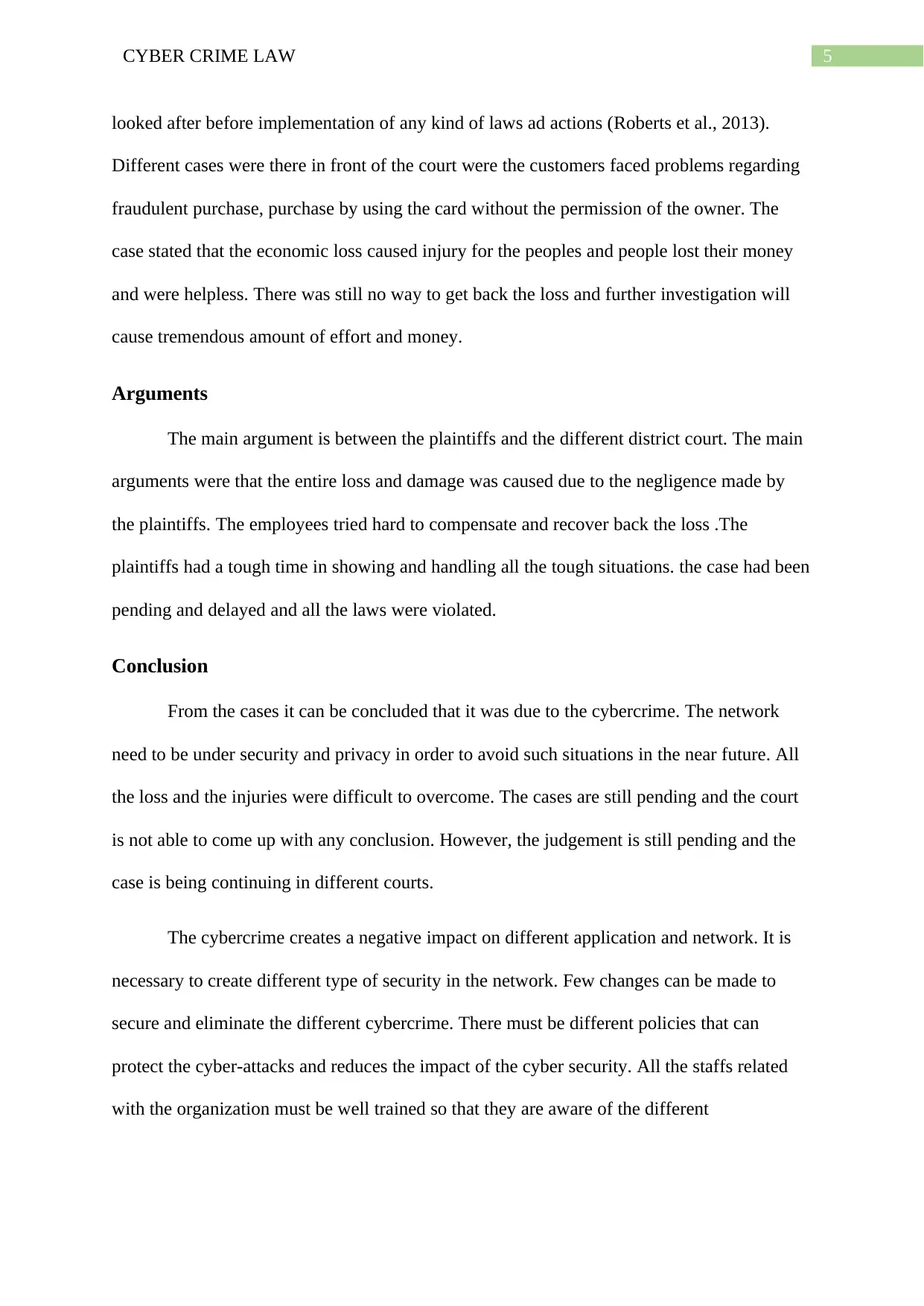
5CYBER CRIME LAW
looked after before implementation of any kind of laws ad actions (Roberts et al., 2013).
Different cases were there in front of the court were the customers faced problems regarding
fraudulent purchase, purchase by using the card without the permission of the owner. The
case stated that the economic loss caused injury for the peoples and people lost their money
and were helpless. There was still no way to get back the loss and further investigation will
cause tremendous amount of effort and money.
Arguments
The main argument is between the plaintiffs and the different district court. The main
arguments were that the entire loss and damage was caused due to the negligence made by
the plaintiffs. The employees tried hard to compensate and recover back the loss .The
plaintiffs had a tough time in showing and handling all the tough situations. the case had been
pending and delayed and all the laws were violated.
Conclusion
From the cases it can be concluded that it was due to the cybercrime. The network
need to be under security and privacy in order to avoid such situations in the near future. All
the loss and the injuries were difficult to overcome. The cases are still pending and the court
is not able to come up with any conclusion. However, the judgement is still pending and the
case is being continuing in different courts.
The cybercrime creates a negative impact on different application and network. It is
necessary to create different type of security in the network. Few changes can be made to
secure and eliminate the different cybercrime. There must be different policies that can
protect the cyber-attacks and reduces the impact of the cyber security. All the staffs related
with the organization must be well trained so that they are aware of the different
looked after before implementation of any kind of laws ad actions (Roberts et al., 2013).
Different cases were there in front of the court were the customers faced problems regarding
fraudulent purchase, purchase by using the card without the permission of the owner. The
case stated that the economic loss caused injury for the peoples and people lost their money
and were helpless. There was still no way to get back the loss and further investigation will
cause tremendous amount of effort and money.
Arguments
The main argument is between the plaintiffs and the different district court. The main
arguments were that the entire loss and damage was caused due to the negligence made by
the plaintiffs. The employees tried hard to compensate and recover back the loss .The
plaintiffs had a tough time in showing and handling all the tough situations. the case had been
pending and delayed and all the laws were violated.
Conclusion
From the cases it can be concluded that it was due to the cybercrime. The network
need to be under security and privacy in order to avoid such situations in the near future. All
the loss and the injuries were difficult to overcome. The cases are still pending and the court
is not able to come up with any conclusion. However, the judgement is still pending and the
case is being continuing in different courts.
The cybercrime creates a negative impact on different application and network. It is
necessary to create different type of security in the network. Few changes can be made to
secure and eliminate the different cybercrime. There must be different policies that can
protect the cyber-attacks and reduces the impact of the cyber security. All the staffs related
with the organization must be well trained so that they are aware of the different
⊘ This is a preview!⊘
Do you want full access?
Subscribe today to unlock all pages.

Trusted by 1+ million students worldwide
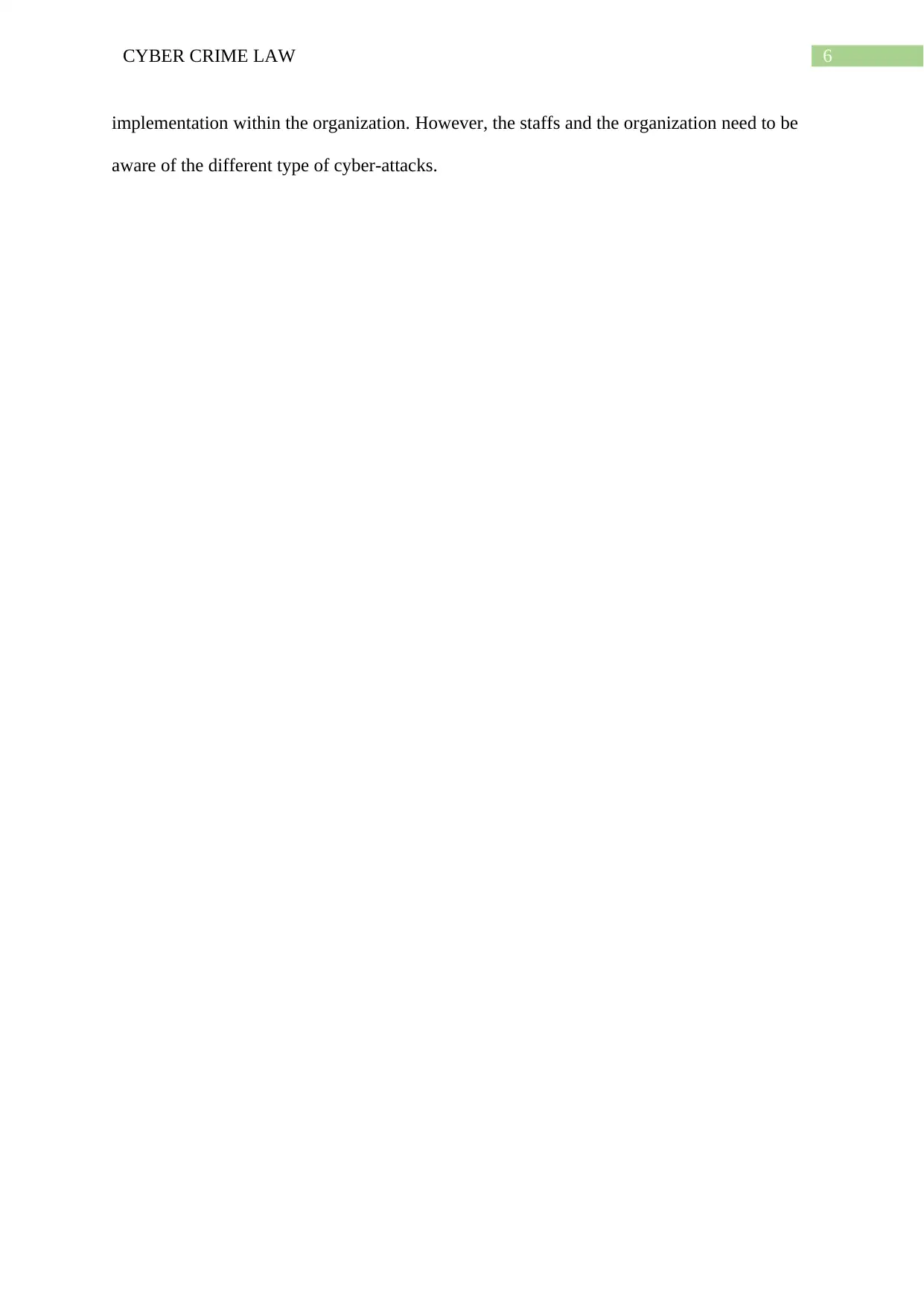
6CYBER CRIME LAW
implementation within the organization. However, the staffs and the organization need to be
aware of the different type of cyber-attacks.
implementation within the organization. However, the staffs and the organization need to be
aware of the different type of cyber-attacks.
Paraphrase This Document
Need a fresh take? Get an instant paraphrase of this document with our AI Paraphraser
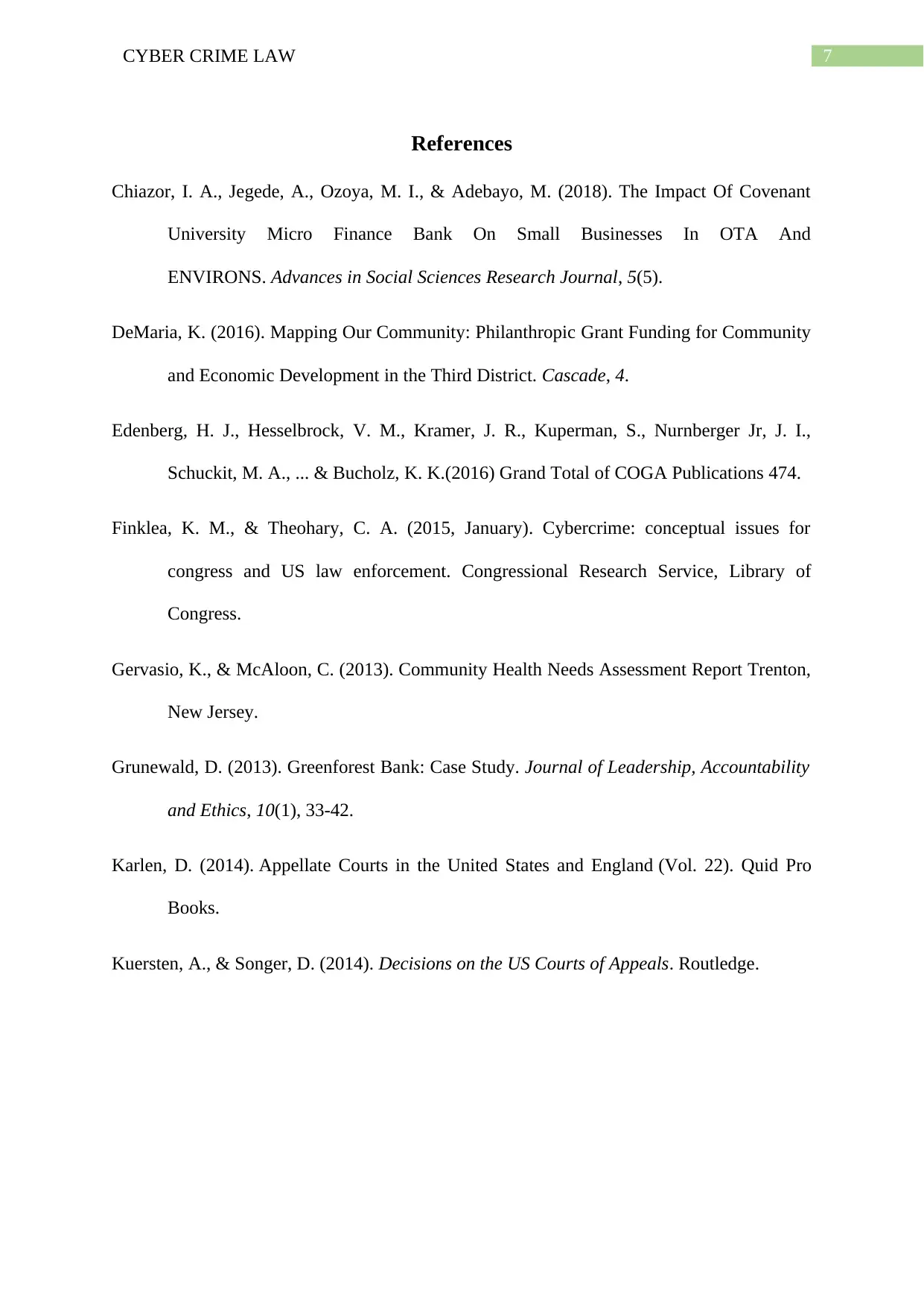
7CYBER CRIME LAW
References
Chiazor, I. A., Jegede, A., Ozoya, M. I., & Adebayo, M. (2018). The Impact Of Covenant
University Micro Finance Bank On Small Businesses In OTA And
ENVIRONS. Advances in Social Sciences Research Journal, 5(5).
DeMaria, K. (2016). Mapping Our Community: Philanthropic Grant Funding for Community
and Economic Development in the Third District. Cascade, 4.
Edenberg, H. J., Hesselbrock, V. M., Kramer, J. R., Kuperman, S., Nurnberger Jr, J. I.,
Schuckit, M. A., ... & Bucholz, K. K.(2016) Grand Total of COGA Publications 474.
Finklea, K. M., & Theohary, C. A. (2015, January). Cybercrime: conceptual issues for
congress and US law enforcement. Congressional Research Service, Library of
Congress.
Gervasio, K., & McAloon, C. (2013). Community Health Needs Assessment Report Trenton,
New Jersey.
Grunewald, D. (2013). Greenforest Bank: Case Study. Journal of Leadership, Accountability
and Ethics, 10(1), 33-42.
Karlen, D. (2014). Appellate Courts in the United States and England (Vol. 22). Quid Pro
Books.
Kuersten, A., & Songer, D. (2014). Decisions on the US Courts of Appeals. Routledge.
References
Chiazor, I. A., Jegede, A., Ozoya, M. I., & Adebayo, M. (2018). The Impact Of Covenant
University Micro Finance Bank On Small Businesses In OTA And
ENVIRONS. Advances in Social Sciences Research Journal, 5(5).
DeMaria, K. (2016). Mapping Our Community: Philanthropic Grant Funding for Community
and Economic Development in the Third District. Cascade, 4.
Edenberg, H. J., Hesselbrock, V. M., Kramer, J. R., Kuperman, S., Nurnberger Jr, J. I.,
Schuckit, M. A., ... & Bucholz, K. K.(2016) Grand Total of COGA Publications 474.
Finklea, K. M., & Theohary, C. A. (2015, January). Cybercrime: conceptual issues for
congress and US law enforcement. Congressional Research Service, Library of
Congress.
Gervasio, K., & McAloon, C. (2013). Community Health Needs Assessment Report Trenton,
New Jersey.
Grunewald, D. (2013). Greenforest Bank: Case Study. Journal of Leadership, Accountability
and Ethics, 10(1), 33-42.
Karlen, D. (2014). Appellate Courts in the United States and England (Vol. 22). Quid Pro
Books.
Kuersten, A., & Songer, D. (2014). Decisions on the US Courts of Appeals. Routledge.
1 out of 8
Related Documents
Your All-in-One AI-Powered Toolkit for Academic Success.
+13062052269
info@desklib.com
Available 24*7 on WhatsApp / Email
![[object Object]](/_next/static/media/star-bottom.7253800d.svg)
Unlock your academic potential
Copyright © 2020–2025 A2Z Services. All Rights Reserved. Developed and managed by ZUCOL.





